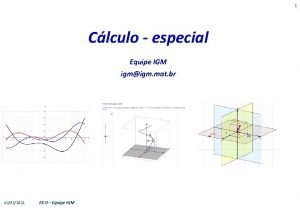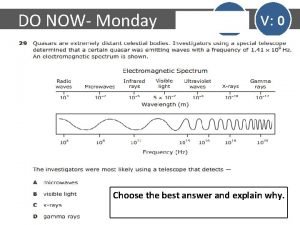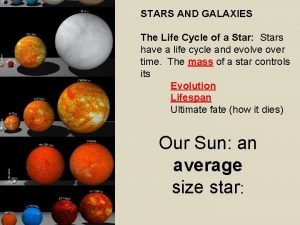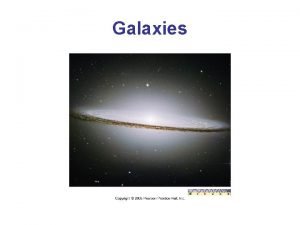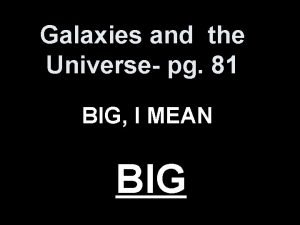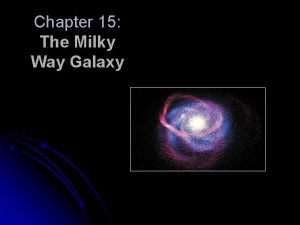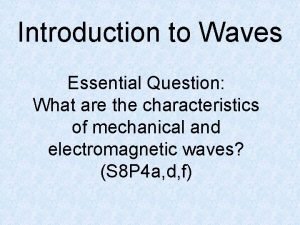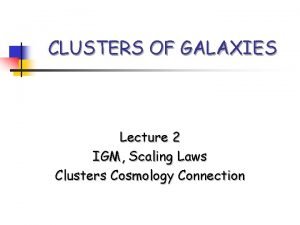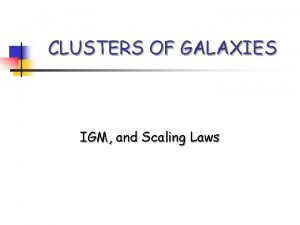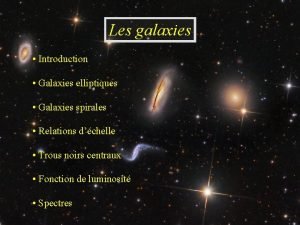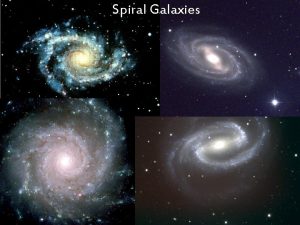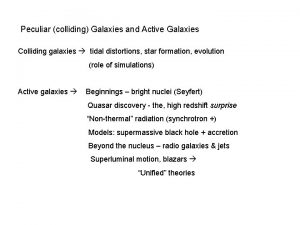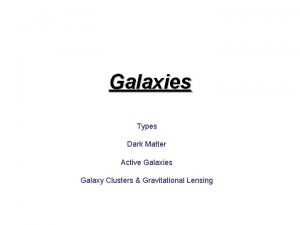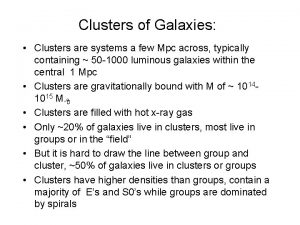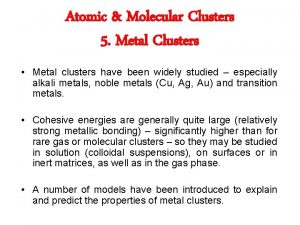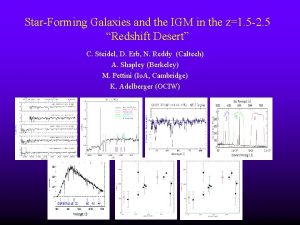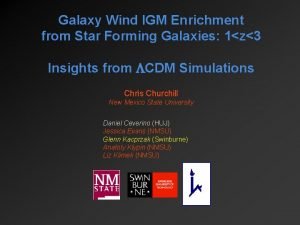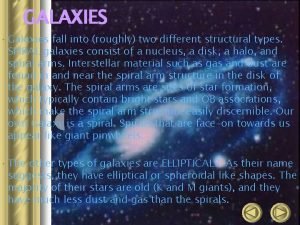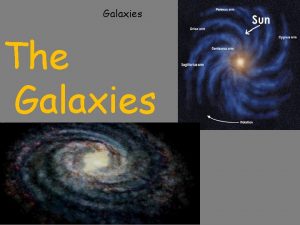CLUSTERS OF GALAXIES The Physics of the IGM




























- Slides: 28

CLUSTERS OF GALAXIES The Physics of the IGM: Cooling Flows

Cooling Flows n Observational evidences n The homogeneous model: one ρ and T at each radius n Observational evidence against homogeneous gas n The inhomogeneous model: Δρ and ΔT at each radius n The role of the magnetic fields in Cooling Flows n Estimates of d. M/dt from imaging & spectral data n The fate of the cooling gas

Cooling in Clusters LX ngas 2 Tg 1/2 Volume E ngas. KTg Volume tcool E/LX Tg 1/2 n-1

Cooling Flows tcool ≈ Tg 1/2 np-1 n For large radii np is small n In the core np is large tcool » t. Hubble tcool ~ t. Hubble The gas within rcool will cool

Cooling Flows When the gas cools The pressure becomes lower The gas flows inwards, The density increases in the center The gas cools even faster

Observational Evidences for Cooling Flows X-Ray Imaging n n Surface brightness strongly peaked at the center

Observational Evidences for Cooling Flows X-Ray Imaging n n Surface brightness strongly peaked at the center Peres et al. (1998)

Observational Evidences for Cooling Flows X-Ray Spectra n n Low ionization lines in soft X-ray spectra Canizares et al. (1984)

Observational Evidences for Cooling Flows X-Ray Spectra n n Temperature gradients towards the center rcool De Grandi & Molendi (2002)

Observational Evidences for Cooling Flows X-Ray Spectra n n Low energy absorption features T(r) Allen et al. (1993) NH(r)

Observational Evidences for Cooling Flows n X-Ray Spectra n Low ionization lines in soft X-ray spectra n Temperature gradients towards the center n Low energy absorption features n No direct evidence of the gas motion, resolution of X-ray detectors is insufficent

Homogeneous Model n Hot gas – one Tg and ng at each r – radiation losses P decreases Gas will flow inwards under the pressure of the overlaying gas n 3 Dynamic regions: 1. r > rcool and tcool > t. Hubble Hydrostatic Equilibrium 2. rgal < rcool with rgal=. 3. r<rgal radius at which the gas falls within potential well of the c. D galaxy

Φ 1 2 3 n Region 2 n n n rcool ΔΦ/Δr is small radiation losses balanced by thermal energy + PV vs>>vfree fall The gas is in quasi-hydrostatic equilibrium Region 3 n rgal ΔΦ/Δr ≠ 0 gravitational energy balances radiation losses r

Hydrodynamic equilibrium for Homogeneous Model 1. Mass conservation 2. Momentum conservation 3. Energy conservation variation of H per unit volume & time Entalphy=thermal E + work by P energy radiated per unit volume & time

. M estimates for Homogeneous model . Energy loss rate . Mass flow rate . Enthalpy . Peres et al. (1998)

Observational evidences against. . The surface brightness is not as peaked as would be expected if all the cooling gas were to reach the center M=const M≠const M rα with α≈1 . . (Fabian, Nulsen & Canizares 1984) A fraction of the gas drops out the flow before reaching the center Most of the cooling gas never makes it to the center Peres et al. (1998)

In-homogeneous Model n Different phases T, ρ coexist at every r n Phases are in Pressure equilibrium (ts<tcool) n n (Nulsen ’ 86) The phases comove with <v> « vs, B field ties the different phases together Heat conduction btw phases must be suppressed, again B fields have been invoked @ T≈106 K tcool ts The cool blobs decouple from the flow and: 1. Fall ballistically? 2. Stay in place as cold gas? 3. Stay in place and form stars?

Summary n n n Gas that is already highly inhomogeneous cools and flows inward under the pressure of the gas immediately on top. The different phases are in pressure equilibrium and comove (B field). When a given phase cools below ≈106 K it falls out of pressure equilibrium while the other phases continue to flow inwards Cold gas deposition occurs on the whole CF region with similar for different clusters (d. M(r)/dt rα) The origin of the density inhomogeneity is unclear: 1. fossil of the past stripping from galaxies (Soker et al. ’ 91) 2. former mergers btw substructures with different T and ρ

. M estimates for in-homogeneous model 1. From Imaging data n . 2. . within the context of the in-homogeneous model ΔLj, luminosity in a given radial shell and Mj mass flow rate in the same shell are related through a linear formula from this, values M can be computed From Spectral data . stricly valid for homogeneous model, reasonable approx. for inhomogeneous model (Wise & Sarazin ’ 93)

. . Comparison btw. Ms and MI Allen (2000)

The role of B fields n n n Tangled field inhibit thermal conduction by increasing the particle mean free path Once a blob has cooled down to ~ 106 K radiation cooling becomes very fast ρ ≈ constant, T decreases, Pgas decreases repressurizing shocks are partially suppressed by the PB At T ~ 106 K trecon ≈ tcool magnetic energy will be converted into thermal energy thereby slowing down the collapse of the blobs.

The fate of the cooling gas n Cooling flow is a frequent phenomenon (~ 60%-70%) n Cooling flow is a persistent phenomenon . [M/(100 M 1. Macc ≈ 1012 Msun [M/(100 Msun/yr)] (Sarazin ’ 89) 2. Macc « Mcluster ≈ 1014 -1015 Msun 3. Macc comparable to mass of the c. D galaxy

The fate of the cooling gas (A) Ionized Cold gas (B) Neutral (C) Molecular (A) Lines observed in optical and UV indicate that ionized gas is present « Macc

The fate of the cooling gas (A) Ionized Cold gas (B) Neutral (C) Molecular (A) (B) Lines observed in optical and UV indicate that ionized gas is present « Macc 21 cm observations in central galaxies give MHI 109 Msun

The fate of the cooling gas (A) Ionized Cold gas (B) Neutral (C) Molecular (A) (B) (C) Lines observed in optical and UV indicate that ionized gas is present « Macc 21 cm observations in central galaxies give MHI 109 Msun Recent obs. (Edge 2002) have detected molecular gas for the first time, again « Macc


SUMMARY n B fields play an important role in CF n A dominating fraction of galaxy clusters feature CF n Analysis of X-ray images and spectra lead to consistent determination of mass deposition rates. n From X-ray observations we find that CF deposit large quantities of cold gas At larger wavelenghts we do not find evidence of such large masses the fate of the cooled gas is unknown .

n n It is somewhat disturbing that all crucial evidences for cooling flows comes from X-ray data Even in the X-rays we do not have direct observational evidence of: 1. flowing gas 2. multiphase gas at one radius
 Hyper igm syndrome
Hyper igm syndrome Jav
Jav Igm antitela pozitivna
Igm antitela pozitivna Catalogo de objetos igm
Catalogo de objetos igm Mat
Mat Brainpop galaxies quiz answers
Brainpop galaxies quiz answers Life cycle of galaxies
Life cycle of galaxies Type of galaxy
Type of galaxy Most galaxies in the inner region of a large cluster are
Most galaxies in the inner region of a large cluster are How are active galaxies classified?
How are active galaxies classified? 4 types of galaxies
4 types of galaxies Facts about elliptical galaxies
Facts about elliptical galaxies Evolution of galaxies
Evolution of galaxies Chapter 30 galaxies and the universe
Chapter 30 galaxies and the universe Elliptical galaxy
Elliptical galaxy Galaxies
Galaxies Billions of galaxies
Billions of galaxies What are galaxies
What are galaxies Waves are produced by stars and galaxies.
Waves are produced by stars and galaxies. Tipus de galaxies
Tipus de galaxies Era of galaxies
Era of galaxies Galaxies lesson plan
Galaxies lesson plan Why does it happen
Why does it happen University physics with modern physics fifteenth edition
University physics with modern physics fifteenth edition Physics ia simulation ideas
Physics ia simulation ideas Waves graphic organizer
Waves graphic organizer Maximal onset principle
Maximal onset principle Cue clusters in nursing
Cue clusters in nursing Mapreduce simplified data processing on large clusters
Mapreduce simplified data processing on large clusters




